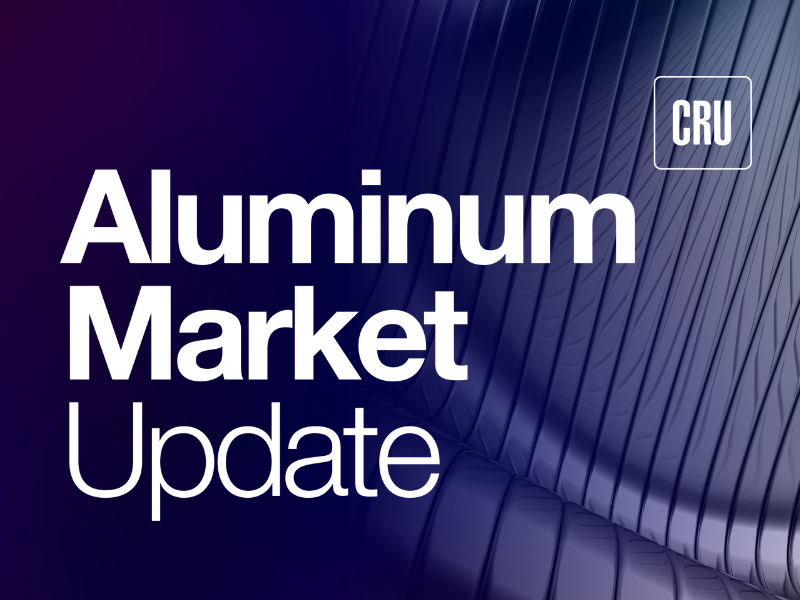Monthly Round-up

July 11, 2025
AMU's June monthly round-up: Tariffs, shifts, and strains
Written by Stephanie Ritenbaugh
There’s a lot of news to keep track of, so we’re lending a hand with highlights from the past month and what they mean for you.
The month of June kicked off with the debut of Aluminum Market Update’s fireside chat, and it proved timely – on the very day the U.S. doubled down on Section 232 tariffs on aluminum and steel. The on-again-off-again tariffs are still sowing uncertainty in aluminum markets, and markets everywhere, as what is being taxed and by how much keeps changing. President Trump has announced his intention to double tariffs on aluminum imports to 50% effective June 4.
Three sessions of the fireside chat tackled the turbulence facing the aluminum market, with insights from trade experts, downstream authorities, and analysts from CRU, our parent company. You can take a look at those discussions here.
But it wasn’t all talk of tariffs. For instance, Ducker Carlisle’s Abey Abraham offered a look aluminum dynamics in the automotive sector. One of Abraham’s more pointed insights concerned the reversion from aluminum back to steel in hang-on parts. These components account for a large share of aluminum sheet use in vehicles and are being swapped for steel alternatives, not for performance reasons but cost control. But that’s just one aspect to monitor in the auto sector.
You may be tempted to tune out copper markets, but don’t just yet. The chaos in copper has real consequences for downstream aluminum operators and processors here in the United States. And things just got more real with Trump indicating the US would implement a higher-than-expected 50% tariff on copper imports.
On the border
Meanwhile, Canada is ramping up its economic counteroffensive against the U.S.’ decision to double tariffs on Canadian aluminum. The moves include reciprocal procurement restrictions, new import quotas, a strategic financing facility for large firms, and the formation of stakeholder task forces for aluminum industries.
Trucks in Juárez are idling. Mexico is waiting. And anyone in the U.S. who relies on aluminum from across the southern border should pay attention to what is happening with U.S. trade policy. Mexico exported around $2.1 billion worth of aluminum into the U.S. last year. That includes everything from coil to billet. If those flows get choked off or slowed down, it’s not just the border that feels it. It’s every can line, auto plant, and warehouse in the U.S. that counts on steady volume.
Supply chains and markets
AMU got the latest rail freight shipments as reported by the Association of American Railroads. Why does it matter? Railroad movements of aluminum are confined to Canadian exports south. Unfortunately, the CN and CP Canadian railroads do not share data with the Association of American Railroads so the that’s why we look at short line and regional movements as an indirect barometer of what’s happening.
The downstream market is feeling the squeeze. From can makers to auto OEMs, everyone is staring down a new cost curve. In some cases, the Midwest premium alone accounts for a third to half of the total delivered price. Trying to pass that through is no easy task. End users in construction, packaging, and consumer goods are already pushing back. Some are delaying orders. Others are testing substitutes. Quotes are sitting in limbo. The pricing environment isn’t just about inflation anymore. It’s about uncertainty. So what should you do? Here are some thoughts.
What the Midwest duty-paid premiums “ought to be.” With the imposition of the 50% tariff under Section 232, AMU’s Greg Wittbecker took a deep dive into the replacement value of Midwest duty paid premiums.
“Any trader worth his/her salt is trained to adhere to the principle of replacement value when managing their risk position in outright price or premium position. You need to know the replacement cost of what you are selling today. You also need to understand how that replacement cost will impact the position you DON’T sell today,” Wittbecker wrote.
Superior Industries, once a major OEM wheel supplier with a long-standing presence in Michigan, is officially off the New York Stock Exchange. It may seem like just a corporate headline, but it carries weight for anyone tied to the aluminum supply chain. Here’s why it matters.
Company happenings
Drivetrain and propulsion systems manufacturer Dana Incorporated is selling its off-highway business to Allison Transmission for $2.7 billion, and it’s likely the scrap generation map for secondary aluminum is quietly being redrawn. Here’s what’s important to note.
Aluminum recycling in aerospace has long been an uphill battle. Even though aircraft are full of high-value aluminum, most of it never finds its way back into high-performance aerospace alloys as scrap. Instead, it’s melted into automotive castings, industrial products, or ends up as DeOx for steel consumption. But a new partnership involving Constellium and TARMAC Aerosave is trying to break that pattern.
Cascade Die Casting plans to expand operations at the company’s High Point, North Carolina operation. The company is investing $8 million into its “Atlantic Division”, with additional support from the local City of High Point and Guilford County to boost infrastructure capacity.
The U.S. building and construction sector, a cornerstone for aluminum demand, is exhibiting signs of instability. But it can be a difficult market to parse out. AMU’s Nicholas Bell looks at the closure of two companies, Oldcastle and Jeld-Wen, and what they can tell us about the tremors in B&C.
The London Metal Exchange’s decision to intervene in Mercuria’s large June aluminum position marks a notable moment in its evolving oversight of the market. According to Bloomberg, the exchange compelled Mercuria to lend out a portion of its position to prevent potential delivery stress, given the size of its long and its significant control over available warehouse inventories. There’s no indication that Mercuria breached any rules. But it prompts the question: When and why does the LME intervene?
On the wire
Cable and wire manufacturer Prysmian Group has signed a long-term manufacturing agreement with power-company Invenergy to supply the Midwest with the largest transmission line in U.S. history.
Prysmian also broke ground on a 650,000-square-foot medium-voltage cable facility on Encore Wire’s Texas campus marks a big development in the aluminum wire and cable sector.
As demand ramps up in data centers, renewable energy, and infrastructure, the expansion is a pivotal shift in North America’s insulated cable mix. Regional production is under pressure to keep pace with the anticipated growth in the wire and cable consumption over the next several years.
With Encore folded in, Prysmian now controls nearly a third of total North American copper and aluminum wire and cable production.
Those are just some of the highlights for June. And we’ll be here to help you keep you finger on the pulse of the aluminum industry.




